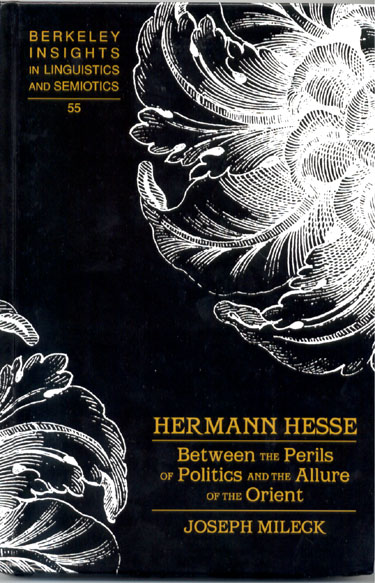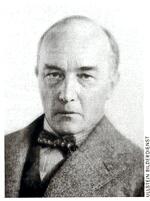

2013-04-06
"Hermann Hesse — the Nobel Prize-winning author of some-of the most widely read novels of this century, including Steppenwolf and Narcissus and Goldnund — did not write an autobiography. But his more than 30;000 letters constitute a remarkable record of his life. For -Soul of the Age, Professor Theodore Ziolkowski has chosen nearly 300 letters from Hesse's personal as well as public correspondence. From his impassioned missives home from the seminary at age fourteen, to his last brief notes, written days before his death at eighty-five, the letters provide an intimate look at Hesse’s intellectual and spiritual world.
These letters, in a bright, fresh rendering by Mark Harman, are intriguing … They capture the full sweep of life devoted to independent self-exploration. Sven Birkerts, NewYork Newsday
Places Hesse and his age in the hands of the involved reader with integrity and intellectual sophistication. Ralph Freedman, author of Hermann Hesse: Pilgrim of Crisis.
An. invaluable, and most engaging source. These are superbly selected letters that illuminate the man and the cultural-and political crosscurrents of his time. Fritz Stern, Seth Low Professor of History, Columbia University.
These letters show Hesse responding with a remarkable integrity and consistency of vision to correspondents famous and obscure, from Thomas Mann .and Carl Jung to young readers' seeking his advice. Eugen Stelzig, Professor of English."
THE NOON DAY PRESS
Farrar, Straus and Giroux. 19 Union Square West, New York 10003
1991
ISBN 0-374-52363-0
Source: Gottschalk Library, Goleta, California
2012-09-04
Barry Stephenson
Veneration and Revolt
Hermann Hesse and Swabian Pietism
"Taking his title from Hesse, Barry Stephenson has given us the first thorough appreciation of the Nobel Prize-winner within the religious culture from which he emerged. Hesse's debt to pietism, against which he rebelled yet which he always venerated as his spiritual heritage, was long a commonplace. But no previous scholar approached the problematic topic with the requisite background in religious studies that informs this book. Beginning with the history of Pietism and its role in Swabia and German Romanticism, it moves through Hesse's life and oeuvre, exposing significant new dimensions from his early religion of art to The Glass Bead Game. This major and highly readable contribution forces us to contemplate Hesse's novels in a wholly original and edifying light."
Theodore Ziolkowski, Princeton University
_____________________________
Veneration and Revolt: Hermann Hesse and Swabian Pietism is the first comprehensive study of the impact of German Pietism (the religion of Hesse's family and native Swabia) on Hesse's life and literature. Hesse's literature bears witness to a lifelong conversation with his religious heritage despite that in adolescence he rejected his family's expectation that he become a theologian, cleric, and missionary.
Hesse's Pietist upbringing and broader Swabian heritage contributed to his moral and political views, his pacifism and internationalism, the confessional and autobiographical style of his literature, his romantic mysticism, his suspicion of bourgeois culture, his ecumenical outlook, and, in an era scarred by two world wars, his hopes for the future. Veneration and Revolt offers a unique perspective on the life and works of one of the twentieth century's most influential writers.Wilfried Laurier University Press
75 University Avenue West
Waterloo, ON (N2L3C5)
Canada
Cloth, 300 Pages
ISBN13:978-1-55458-149-8
Canadian $ 85.00
For more information contact Clare Hitchens, publicist,
Source: University of Toronto Quarterly
2004-02-21
Joseph Mileck
Between the Perils of Politics
and the Allure of the Orient
2003

Moral conviction, not political inclination, determined Hermann Hesse's participation in German sociopolitical matters. The belief that artists, the ever-alert guardians of human values and cultural heritage, were society's admonishing conscience, determined Hesse's sociopolitical engagement, fashioned his considerable body of political articles, and made him a chronic persona non grata in Germany. It was likewise not the spiritual lure of the Orient that drew Hesse eastward - for him, the East was less a spiritual journey than an aesthetic adventure. Although Hesse remained a Westerner in thought and belief, his art acquired an enriching exotic cast and his essays and reviews an added Eastern dimension.
This bipartite study focuses upon these two evolving major engagements - Hesse's continuous adult sociopolitical involvements and his lifelong preoccupation with Eastern thought and belief, both firmly rooted in his family's passionate Pietist dedication to the service of God and humankind - and their impact upon both Hesse and his writings.
This is a thoroughly scholarly study and a welcome update on Hesse research in the best tradition of Professor Mileck's previous, invaluable discerning contributions to the study of Hesse's life and works!
HHP
Contents
Foreword
Part I
THE ARTIST AND POLITICS
Hesse's Sociopolitical Involvements
and the RepercussionsProlegomena 3
The Monarchy and Pietism 8
The First World War: Seduction and Reaction 17
Social and Political Involvements during the Weimar Republic 28
The Third Reich: Silence and Defamation 33
Renewed Social and Political Involvements 38
after the Second World War
Celebrity and Notoriety 42
Flirtation with Communism 45
East Germany's Courtship 52
America, Russia, and the Future 59
Elder Literary Statesman 61Notes 65
Selected Bibliography 81
Part II
HESSE AND INDIA
Acclaim and Disclaim
Scholarship to Date
Prelude 87
Dissertations 89
Articles 108
Summation and Addendum 123
Eastward-Ho
Early Exposure to India 127
Introduction to India's Religious Texts 130
Hesse and China 135
Abortive Trip to the East 136
New Possibility: From Self-Denial to Self-Assertion 139
Early Indian Tales 141
Siddhartha: Genesis 144
Siddhartha: Eastern Manner and Western Matter 149
The Years Following Siddhartha 152
India's Literary-Aesthetic Attraction 155
Das Glasperlenspiel: Indischer Lebenslauf 15Contents ix
Zen Buddhism 162
Summation and Addendum 163Notes 165
Selected Bibliography 181
Index of Hesse's Works 187
Index of Names 191
Index of Subjects 195
New York: Peter Lang, 2003
www.peterlangusa.com
(Caution: As of 9/29/03 the URL for Peter Lang, USA, has not yet been updated to include this book)Berkeley Insights in Linguistics and Semiotics
Irmengard Rauch, General Editor, Vol. 55ISBN 0-8204-6790-1
Source: J. Mileck
2003-01-11
Robert H. Farquharson

Toronto: Forum House © 1973
ppb, 107 pp
Contents:
1 .Hesse's Life
2. Beneath the Wheel
3. Demian
4. Siddhartha
5. Steppenwolf
6. The Glass Bead Game
Conclusion
Chronology
Pronuciation Guide
Bibliography
April 18, 2002
![[The Fairy Tales of Hermann Hesse, New York: Banyam, 1995. Cover illustration © David Frampton, 1995]](fairy-tales.jpg)
A Bantam Trade Paperback (Classics)
New York: Bantam, 1995ISBN 0-553-10023-8 hc
ISBN 0-553-37776-0 pb
263 pp
$14.95 pb
March 16, 2002Robert Musil
The Confusions of Young Törless
![[Book cover of Musil The Confusions of Young Toerless, © Penguin, 2001]](toerless.jpg)
With an Introduction by ©
J. M. Coetzee, 2001
Translation by ©
Shaun Whiteside, 2001
Copyright of the original:
©
Rowohlt Verlag GmbH, 1978
 Like his contemporary and rival Sigmund Freud, Robert Musil boldly explored the dark, irrational undercurrents beneath the calm surface of bourgeois life. The Confusions of Young Törless, published while he was a student, uncovers the bullying, snobbery, and vicious homoerotic violence at an elite boys' academy. Unsparingly honest in its depiction of the author's tangled
feelings about his mother, other women, and male bonding, it also vividly
illustrates the crisis of a whole society, where the breakdown of traditional
values and the cult of pitiless masculine strength were soon to lead to
the cataclysm of the First World War and later to the rise of fascism.
A century later, Musil's first novel still retains its shocking, prophetic
power. (Text on back cover)
|
160 pp. paperback
ISBN 0 14 21. 8000 9
![[The Journey to the West, tr. by Anthony C. Yu, U.of Chicago Press, 2001]](journey-west.jpg)
"First published in 1592, "The Journey to the West", volume I, comprises the first twenty-five chapters of Anthony C. Yu's four volume translation of Hsi-yu Chi, one of the most beloved classics of Chinese literature. The fantastic tale recounts the sixteen-year pilgrimage of the monk Hsüan-tsang (596-664), one of China's most illustrious religious heroes, who journeyed to India with four animal disciples in quest of Buddhist scriptures. For nearly a thousand years, his exploits were celebrated and embellished in various accounts, culminating in the hundred-chapter "Journey to the West", which combines religious allegory with romance, fantasy, humor, and satire." (back cover text)
|
|
All materials are posted as a non-profit
public educational service
If you have questions, comments,
or technical problems with this page, please send email to the
Hermann-Hesse-Project
at the University
of California, Santa Barbara
Optimized for Netscape browsers